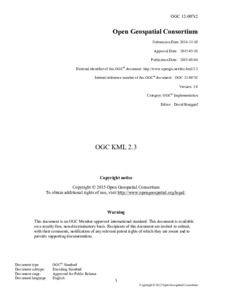| dc.contributor.editor | David Burggraf | |
| dc.date.accessioned | 2019-09-30T18:52:30Z | |
| dc.date.available | 2019-09-30T18:52:30Z | |
| dc.date.issued | 2015 | |
| dc.identifier.citation | Burggraf, D. (ed.) (2015) OGC KML 2.3, Version 1.0. Wayland, MA, Open Geospatial Consortium, 266pp. (OGC 12-007r2). DOI: http://dx.doi.org/10.25607/OBP-598 | en_US |
| dc.identifier.uri | http://hdl.handle.net/11329/1070 | |
| dc.identifier.uri | http://dx.doi.org/10.25607/OBP-598 | |
| dc.description.abstract | KML is an XML grammar used to encode and transport representations of geographic data for display in an earth browser. Put simply: KML encodes what to show in an earth browser, and how to show it. KML uses a tag-based structure with nested elements and attributes and is based on the XML standard.
The KML community is wide and varied. Casual users create KML Placemarks to identify their homes, describe journeys, and plan cross-country hikes and cycling ventures. Scientists use KML to provide detailed mappings of resources, models, and trends such as volcanic eruptions, weather patterns, earthquake activity, and mineral deposits. Real estate professionals, architects, and city development agencies use KML to propose construction and visualize plans. Students and teachers use KML to explore people, places, and events, both historic and current. Organizations such as National Geographic, UNESCO, and the Smithsonian have all used KML to display their rich sets of global data.
KML documents and their related images (if any) may be compressed using the ZIP format into KMZ archives. KML documents and KMZ archives may be shared by e‑mail, hosted locally for sharing within a private internet, or hosted on a web server. | en_US |
| dc.language.iso | en | en_US |
| dc.publisher | Open Geospatial Consortium | en_US |
| dc.relation.ispartofseries | OGC;12-007r2 | |
| dc.subject.other | OGC | en_US |
| dc.title | OGC KML 2.3, Version 1.0. | en_US |
| dc.type | Report | en_US |
| dc.description.status | Published | en_US |
| dc.format.pages | 266pp | en_US |
| dc.description.refereed | Refereed | en_US |
| dc.publisher.place | Wayland, MA | en_US |
| dc.description.currentstatus | Current | en_US |
| dc.description.maturitylevel | TRL 9 Actual system "mission proven" through successful mission operations (ground or space) | en_US |
| dc.description.bptype | Standard | en_US |
| obps.contact.contactemail | standards@opengeospatial.org | |
| obps.resourceurl.publisher | http://www.opengeospatial.org/docs/is | en_US |
 Repository of community practices in Ocean Research, Applications and Data/Information Management
Repository of community practices in Ocean Research, Applications and Data/Information Management
